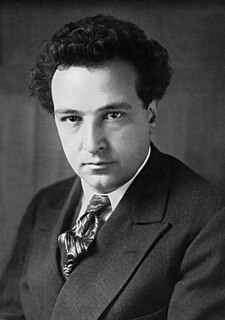Related Research Articles

Opus 70 is a set of two Piano Trios by Ludwig van Beethoven, written for piano, violin, and cello. Both trios were composed during Beethoven's stay at Countess Marie von Erdödy's estate, and both are dedicated to her for her hospitality. They were published in 1809.

Hugo Emil Alfvén was a Swedish composer, conductor, violinist, and painter.
Ellora is one of the largest rock-cut monastery-temple cave complexes in the world, and a UNESCO World Heritage Site in Maharashtra, India.

Pulcinella is a one-act ballet by Igor Stravinsky based on an 18th-century play, Quatre Polichinelles semblables. Pulcinella is a stock character originating from commedia dell'arte.

Lobgesang, Op. 52, is a 13-movement "Symphony-Cantata on Words of the Holy Bible for Soloists, Choir and Orchestra" by Felix Mendelssohn. After the composer's death it was published as his Symphony No. 2 in B-flat major, a naming and a numbering that are not his. The required soloists are two sopranos and a tenor. An organ is needed too. The work lasts almost twice as long as any of Mendelssohn's purely instrumental symphonies.
The Symphony No. 98 in B♭ major, Hoboken I/98, is the sixth of the twelve London symphonies composed by Joseph Haydn. It was completed in 1792 as part of the set of symphonies composed on his first trip to London. It was first performed at the Hanover Square Rooms in London on 2 March 1792.

Yasushi Akutagawa was a Japanese composer and conductor. He was born and raised in Tabata, Tokyo. His father was Ryūnosuke Akutagawa.

The Symphony No. 59 in A major is a relatively early work by Joseph Haydn that is known popularly as the Fire Symphony. Composed under the auspices of Nikolaus Esterházy, it was written in the middle or late 1760s.

The Symphony No. 52 in C minor is one of the last Sturm und Drang symphonies composed by the Austrian composer Joseph Haydn while the composer was in residence at Esterházy in 1771 or 1772.

The Concerto for Violin and String Orchestra in D minor was composed by Felix Mendelssohn at the age of thirteen. It has three movements, Allegro–Andante–Allegro, and performance duration is approximately 22 minutes.
The Symphony No. 5 in F major, Op. 76, B. 54, is a classical composition by Czech composer Antonín Dvořák. It was originally published as Symphony No. 3.
The Symphony No. 4 in D minor, Op. 13, B. 41, is a classical composition by Czech composer Antonín Dvořák.

The Symphony No. 3 in E♭ major, Op. 10, B. 34 is a classical composition by Czech composer Antonín Dvořák.

Symphonie Liturgique is the Third Symphony by the Swiss composer Arthur Honegger.
The Sinfonia Concertante in B flat major, by Joseph Haydn was composed in London between February and March 1792. The work is a sinfonia concertante with four instruments in the solo group: violin, cello, oboe and bassoon. It is believed to be a response to similar works composed by Ignaz Pleyel, a former student of Haydn's who London newspapers were promoting as a 'rival' to Haydn. In addition to the solo group the Sinfonia Concertante is scored for flute, 2 oboes, 2 bassoons, 2 horns, 2 trumpets, timpani and strings.
Symphony No. 4, subtitled Sinfonía romántica is an orchestral composition by Carlos Chávez, composed in 1953.

Symphony No. 5, also called Sinfonía para cuerdas is a composition for string orchestra by Carlos Chávez, composed in 1953.

Symphony No. 6 is an orchestral work by Carlos Chávez, composed in 1961–62.
Bohuslav Martinů's Symphony No. 2, H. 295, was composed from May 29 to July 24, 1943 under a commission from the Czech community in Cleveland. It was premiered by the Cleveland Orchestra conducted by Erich Leinsdorf on October 28 that year, which marked the 25th anniversary of the foundation of Czechoslovakia, then downgraded to a Czech protectorate and Slovak puppet state under German occupation.
Joseph Touchemoulin was a French violinist and composer of the classical period who mainly worked in Bonn and Regensburg.
References
- Akutagawa - Ellora Symphony, Trinita Sinfonica, Rapsodia. New Zealand Symphony Orchestra, Takuo Yuasa. Naxos Records. Booklet notes by Morihide Katayama.